Advance Mental Health Nursing: Aggression Management Strategies Report
VerifiedAdded on 2023/01/11
|9
|2740
|60
Report
AI Summary
This report delves into the critical issue of managing aggression and violence within inpatient psychiatric settings, examining the seemingly contradictory approaches of zero tolerance policies and the movement to abolish restrictive practices. It provides a detailed analysis of these two approaches, highlighting their arguments and consequences. The report then critically discusses various alternative management strategies, including staff training, the creation of a therapeutic culture, and leadership improvements. It emphasizes the importance of finding a balance between these practices to ensure the safety of both staff and patients while respecting the rights of individuals. The report concludes by stressing the need for psychiatric settings to adopt a comprehensive approach that addresses aggression and violence effectively and ethically.

ADVANCE MENTAL
HEALTH NURSING
HEALTH NURSING
Paraphrase This Document
Need a fresh take? Get an instant paraphrase of this document with our AI Paraphraser

Table of Contents
INTRODUCTION...........................................................................................................................1
ZERO TOLERANCE......................................................................................................................1
ABOLISHMENT OF RESTRICTIVE PRACTICES......................................................................2
CRITICAL DISCUSSION OF MANAGEMENT STRATEGIES.................................................4
CONCLUSION................................................................................................................................5
REFERENCES................................................................................................................................7
INTRODUCTION...........................................................................................................................1
ZERO TOLERANCE......................................................................................................................1
ABOLISHMENT OF RESTRICTIVE PRACTICES......................................................................2
CRITICAL DISCUSSION OF MANAGEMENT STRATEGIES.................................................4
CONCLUSION................................................................................................................................5
REFERENCES................................................................................................................................7

INTRODUCTION
Mental Health Nursing is one of the most critical and effective area of study and practice
that is directly associated with handling patients within health facilities that are suffering from
mental illness (Zugai, Stein-Parbury & Roche, 2015). At the same time, it is imperative that the
care and assistance given to the individuals is in adherence of their rights in an appropriate
manner. However, within Australia, as well as globally, there are two movements or approaches
which are being implemented within mental health service in which one approach is related to
the “Zero Tolerance” policy towards aggression and violence and the other is related to
abolishment of restrictive practices in mental health. Therefore, in regards to this, the report
below is based on critical discussion of alternate management strategies for containment of
aggression and violence in inpatient psychiatric settings.
ZERO TOLERANCE
Violence against health and social care workers within mental health facilities is one of
the widely researched and debatable topics in the current global healthcare environment. The
reason for the same is that the individuals adopting this profession are usually the very first ones
who come in contact with patients with mental illness within healthcare settings and hence are
the primary ones who indulge in the process of triage, which is a procedure that is required to
determine the intensity, as well as severity of the level of illness which a patient is currently
suffering. This also includes anticipating the level of urgency which is necessary to be adhered to
in providing the patient with medical assistance. However, sometimes delay in services, or other
issue within the facility seems to trigger the violence in these individuals which are then
showcased upon healthcare workers as it has been widely witnessed within the past years
(Adams, 2015).
Therefore, in response to this, Zero Tolerance Policy has been adopted by the mental
health organisations across Australia which was directed against any act of violence or
aggression that could put the health and safety of patients as well as individuals in jeopardy.
The policy has been intended to function in an effective and ethical manner which does
not direct the healthcare worker that any appropriate action is required to be taken in response to
the violent behaviour of individuals, rather dealing the situation with necessary clinical
1
Mental Health Nursing is one of the most critical and effective area of study and practice
that is directly associated with handling patients within health facilities that are suffering from
mental illness (Zugai, Stein-Parbury & Roche, 2015). At the same time, it is imperative that the
care and assistance given to the individuals is in adherence of their rights in an appropriate
manner. However, within Australia, as well as globally, there are two movements or approaches
which are being implemented within mental health service in which one approach is related to
the “Zero Tolerance” policy towards aggression and violence and the other is related to
abolishment of restrictive practices in mental health. Therefore, in regards to this, the report
below is based on critical discussion of alternate management strategies for containment of
aggression and violence in inpatient psychiatric settings.
ZERO TOLERANCE
Violence against health and social care workers within mental health facilities is one of
the widely researched and debatable topics in the current global healthcare environment. The
reason for the same is that the individuals adopting this profession are usually the very first ones
who come in contact with patients with mental illness within healthcare settings and hence are
the primary ones who indulge in the process of triage, which is a procedure that is required to
determine the intensity, as well as severity of the level of illness which a patient is currently
suffering. This also includes anticipating the level of urgency which is necessary to be adhered to
in providing the patient with medical assistance. However, sometimes delay in services, or other
issue within the facility seems to trigger the violence in these individuals which are then
showcased upon healthcare workers as it has been widely witnessed within the past years
(Adams, 2015).
Therefore, in response to this, Zero Tolerance Policy has been adopted by the mental
health organisations across Australia which was directed against any act of violence or
aggression that could put the health and safety of patients as well as individuals in jeopardy.
The policy has been intended to function in an effective and ethical manner which does
not direct the healthcare worker that any appropriate action is required to be taken in response to
the violent behaviour of individuals, rather dealing the situation with necessary clinical
1
⊘ This is a preview!⊘
Do you want full access?
Subscribe today to unlock all pages.

Trusted by 1+ million students worldwide
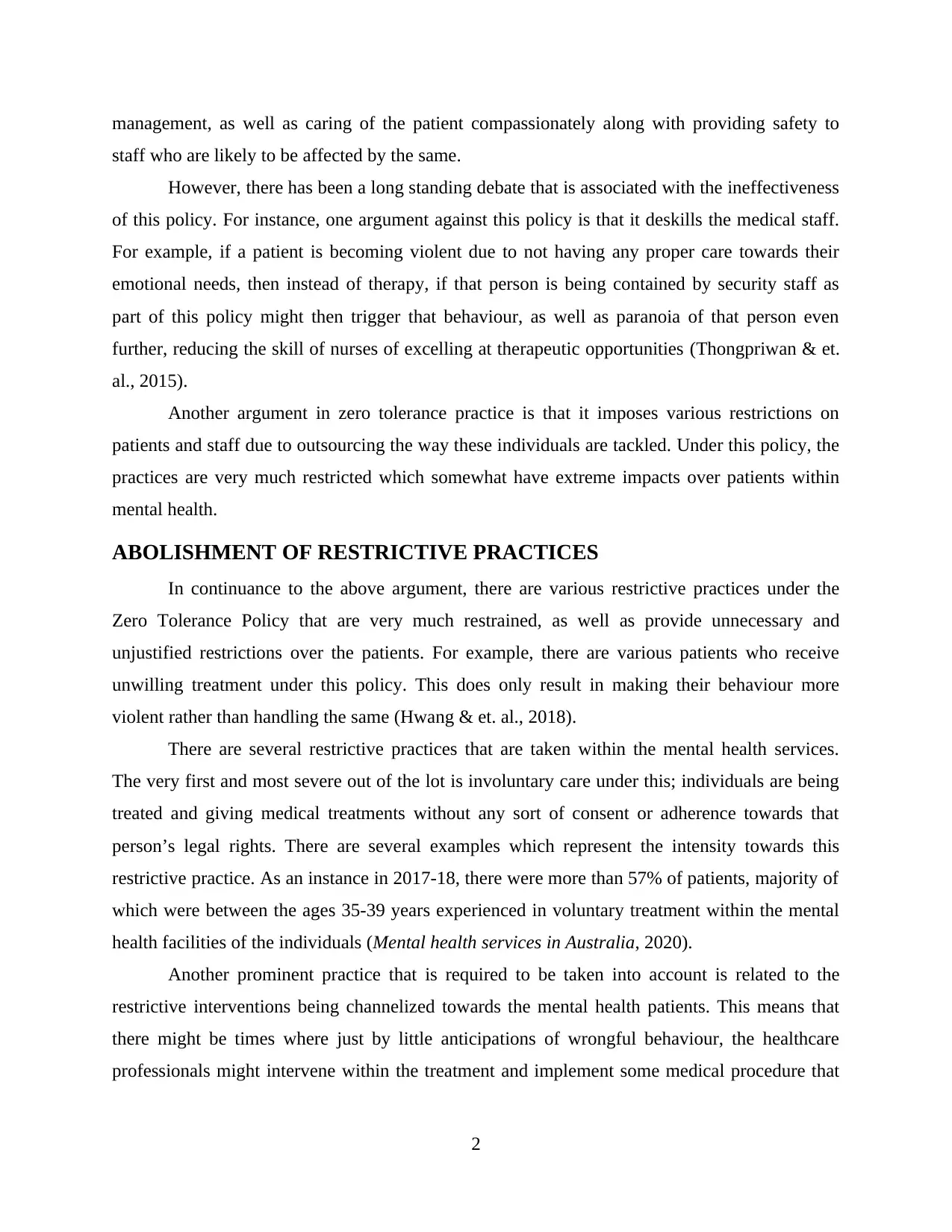
management, as well as caring of the patient compassionately along with providing safety to
staff who are likely to be affected by the same.
However, there has been a long standing debate that is associated with the ineffectiveness
of this policy. For instance, one argument against this policy is that it deskills the medical staff.
For example, if a patient is becoming violent due to not having any proper care towards their
emotional needs, then instead of therapy, if that person is being contained by security staff as
part of this policy might then trigger that behaviour, as well as paranoia of that person even
further, reducing the skill of nurses of excelling at therapeutic opportunities (Thongpriwan & et.
al., 2015).
Another argument in zero tolerance practice is that it imposes various restrictions on
patients and staff due to outsourcing the way these individuals are tackled. Under this policy, the
practices are very much restricted which somewhat have extreme impacts over patients within
mental health.
ABOLISHMENT OF RESTRICTIVE PRACTICES
In continuance to the above argument, there are various restrictive practices under the
Zero Tolerance Policy that are very much restrained, as well as provide unnecessary and
unjustified restrictions over the patients. For example, there are various patients who receive
unwilling treatment under this policy. This does only result in making their behaviour more
violent rather than handling the same (Hwang & et. al., 2018).
There are several restrictive practices that are taken within the mental health services.
The very first and most severe out of the lot is involuntary care under this; individuals are being
treated and giving medical treatments without any sort of consent or adherence towards that
person’s legal rights. There are several examples which represent the intensity towards this
restrictive practice. As an instance in 2017-18, there were more than 57% of patients, majority of
which were between the ages 35-39 years experienced in voluntary treatment within the mental
health facilities of the individuals (Mental health services in Australia, 2020).
Another prominent practice that is required to be taken into account is related to the
restrictive interventions being channelized towards the mental health patients. This means that
there might be times where just by little anticipations of wrongful behaviour, the healthcare
professionals might intervene within the treatment and implement some medical procedure that
2
staff who are likely to be affected by the same.
However, there has been a long standing debate that is associated with the ineffectiveness
of this policy. For instance, one argument against this policy is that it deskills the medical staff.
For example, if a patient is becoming violent due to not having any proper care towards their
emotional needs, then instead of therapy, if that person is being contained by security staff as
part of this policy might then trigger that behaviour, as well as paranoia of that person even
further, reducing the skill of nurses of excelling at therapeutic opportunities (Thongpriwan & et.
al., 2015).
Another argument in zero tolerance practice is that it imposes various restrictions on
patients and staff due to outsourcing the way these individuals are tackled. Under this policy, the
practices are very much restricted which somewhat have extreme impacts over patients within
mental health.
ABOLISHMENT OF RESTRICTIVE PRACTICES
In continuance to the above argument, there are various restrictive practices under the
Zero Tolerance Policy that are very much restrained, as well as provide unnecessary and
unjustified restrictions over the patients. For example, there are various patients who receive
unwilling treatment under this policy. This does only result in making their behaviour more
violent rather than handling the same (Hwang & et. al., 2018).
There are several restrictive practices that are taken within the mental health services.
The very first and most severe out of the lot is involuntary care under this; individuals are being
treated and giving medical treatments without any sort of consent or adherence towards that
person’s legal rights. There are several examples which represent the intensity towards this
restrictive practice. As an instance in 2017-18, there were more than 57% of patients, majority of
which were between the ages 35-39 years experienced in voluntary treatment within the mental
health facilities of the individuals (Mental health services in Australia, 2020).
Another prominent practice that is required to be taken into account is related to the
restrictive interventions being channelized towards the mental health patients. This means that
there might be times where just by little anticipations of wrongful behaviour, the healthcare
professionals might intervene within the treatment and implement some medical procedure that
2
Paraphrase This Document
Need a fresh take? Get an instant paraphrase of this document with our AI Paraphraser

is not required to that patient. As a result, it causes distress in patient which later on becomes a
facilitator of a hostile or aggressive behaviour (Kershaw & et. al., 2015).
Seclusion refers to the practice of confinement of an individual during any time of the
day to an area where the exit of that patient is strictly prohibited and is yet another restrictive
practice adopted within the mental health services across the country and beyond. While the
agenda of the same is mostly towards provision of safety to the health staff, it might be
frustrating to the patient, along with their peers or even people providing support to these
individuals (Crowe, Inder & Porter, 2015).
All these practices are very much being opposed by masses not in just Australia but
globally. There is a worldwide movement which seeks complete demolition of restrictive
practices within the mental health organisations and people are determined towards providing the
patients with their rights. Moreover, there are various healthcare organisations that have even
implemented various steps that are in accordance with the movement and work towards
demolishing such restrictive practices. As few examples, healthcare facilities are not working
upon improvised leaderships, as well as governance, along with programmes towards reduction
of the interventions. Along with this, person-centred care has also been adopted by the
individuals in appropriate manner. In addition to this, therapeutic culture is also being enhanced
within the care facilities.
However, there is a debate in this approach as well just like the previous ones. For
example, it is believed that reducing and ultimately demolishing restrictive practice would be
quite inconvenient towards the protection and safety of patients and healthcare staff from
potentially dangerous individuals, which are the ones with a rapidly degrading mental health and
massive signs of aggressive, disruptive and violent signs of behaviour. Another argument against
this practice is that without any superior intervention and restrictions, patients would soon
believe that any practices in which they indulge in are very much justified. This potentially
would be very much harmful for the patients, along with healthcare staff, especially nurses who
have to support a variety of needs of these individuals and are bound to be within their contact
multiple times throughout the day (Hastings, Kroposki & Williams, 2017).
Hence, there are benefits and consequences of both the practices mentioned above which
makes it very necessary for the healthcare department of Australia towards determining the
balance in both these approaches through several strategies that are sustainable and effective
3
facilitator of a hostile or aggressive behaviour (Kershaw & et. al., 2015).
Seclusion refers to the practice of confinement of an individual during any time of the
day to an area where the exit of that patient is strictly prohibited and is yet another restrictive
practice adopted within the mental health services across the country and beyond. While the
agenda of the same is mostly towards provision of safety to the health staff, it might be
frustrating to the patient, along with their peers or even people providing support to these
individuals (Crowe, Inder & Porter, 2015).
All these practices are very much being opposed by masses not in just Australia but
globally. There is a worldwide movement which seeks complete demolition of restrictive
practices within the mental health organisations and people are determined towards providing the
patients with their rights. Moreover, there are various healthcare organisations that have even
implemented various steps that are in accordance with the movement and work towards
demolishing such restrictive practices. As few examples, healthcare facilities are not working
upon improvised leaderships, as well as governance, along with programmes towards reduction
of the interventions. Along with this, person-centred care has also been adopted by the
individuals in appropriate manner. In addition to this, therapeutic culture is also being enhanced
within the care facilities.
However, there is a debate in this approach as well just like the previous ones. For
example, it is believed that reducing and ultimately demolishing restrictive practice would be
quite inconvenient towards the protection and safety of patients and healthcare staff from
potentially dangerous individuals, which are the ones with a rapidly degrading mental health and
massive signs of aggressive, disruptive and violent signs of behaviour. Another argument against
this practice is that without any superior intervention and restrictions, patients would soon
believe that any practices in which they indulge in are very much justified. This potentially
would be very much harmful for the patients, along with healthcare staff, especially nurses who
have to support a variety of needs of these individuals and are bound to be within their contact
multiple times throughout the day (Hastings, Kroposki & Williams, 2017).
Hence, there are benefits and consequences of both the practices mentioned above which
makes it very necessary for the healthcare department of Australia towards determining the
balance in both these approaches through several strategies that are sustainable and effective
3
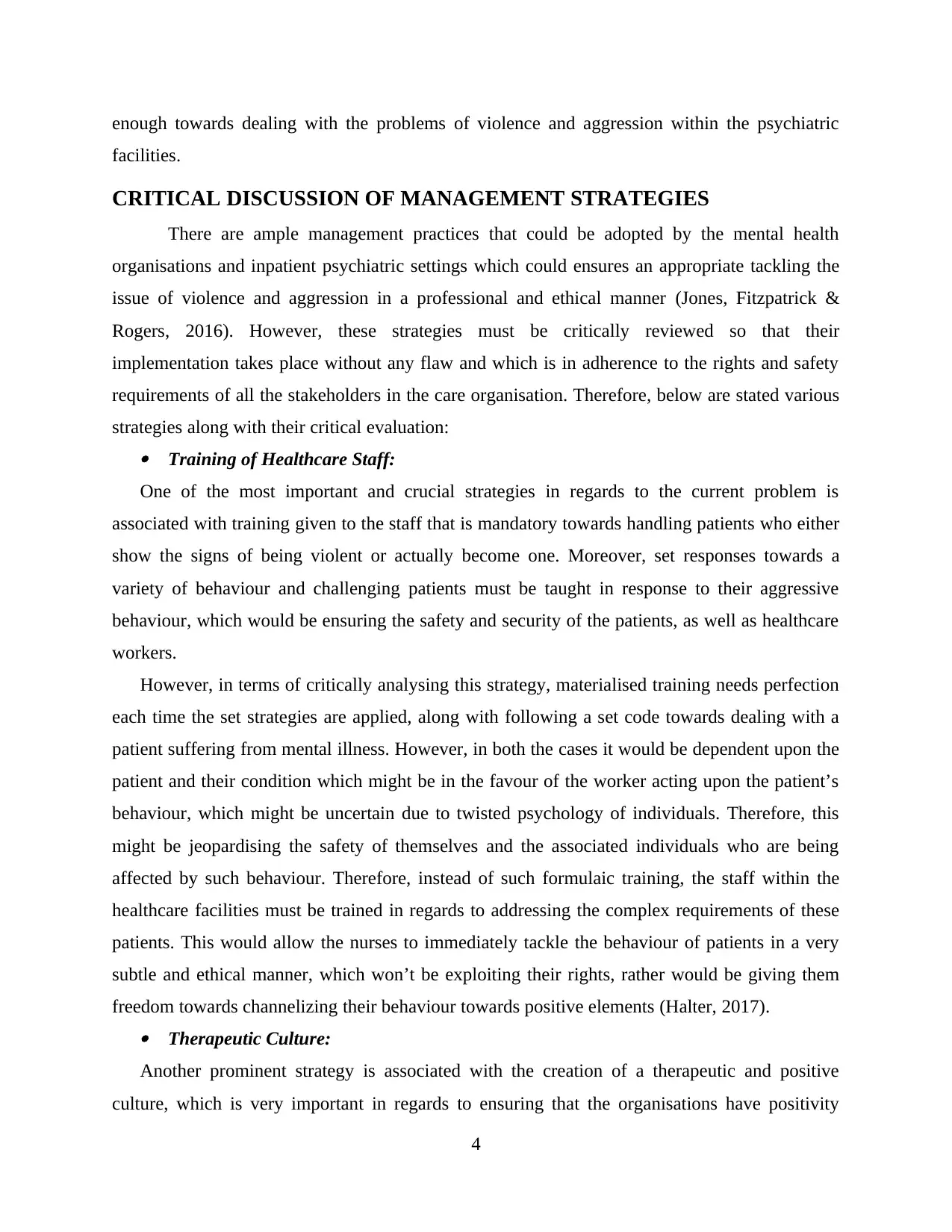
enough towards dealing with the problems of violence and aggression within the psychiatric
facilities.
CRITICAL DISCUSSION OF MANAGEMENT STRATEGIES
There are ample management practices that could be adopted by the mental health
organisations and inpatient psychiatric settings which could ensures an appropriate tackling the
issue of violence and aggression in a professional and ethical manner (Jones, Fitzpatrick &
Rogers, 2016). However, these strategies must be critically reviewed so that their
implementation takes place without any flaw and which is in adherence to the rights and safety
requirements of all the stakeholders in the care organisation. Therefore, below are stated various
strategies along with their critical evaluation: Training of Healthcare Staff:
One of the most important and crucial strategies in regards to the current problem is
associated with training given to the staff that is mandatory towards handling patients who either
show the signs of being violent or actually become one. Moreover, set responses towards a
variety of behaviour and challenging patients must be taught in response to their aggressive
behaviour, which would be ensuring the safety and security of the patients, as well as healthcare
workers.
However, in terms of critically analysing this strategy, materialised training needs perfection
each time the set strategies are applied, along with following a set code towards dealing with a
patient suffering from mental illness. However, in both the cases it would be dependent upon the
patient and their condition which might be in the favour of the worker acting upon the patient’s
behaviour, which might be uncertain due to twisted psychology of individuals. Therefore, this
might be jeopardising the safety of themselves and the associated individuals who are being
affected by such behaviour. Therefore, instead of such formulaic training, the staff within the
healthcare facilities must be trained in regards to addressing the complex requirements of these
patients. This would allow the nurses to immediately tackle the behaviour of patients in a very
subtle and ethical manner, which won’t be exploiting their rights, rather would be giving them
freedom towards channelizing their behaviour towards positive elements (Halter, 2017). Therapeutic Culture:
Another prominent strategy is associated with the creation of a therapeutic and positive
culture, which is very important in regards to ensuring that the organisations have positivity
4
facilities.
CRITICAL DISCUSSION OF MANAGEMENT STRATEGIES
There are ample management practices that could be adopted by the mental health
organisations and inpatient psychiatric settings which could ensures an appropriate tackling the
issue of violence and aggression in a professional and ethical manner (Jones, Fitzpatrick &
Rogers, 2016). However, these strategies must be critically reviewed so that their
implementation takes place without any flaw and which is in adherence to the rights and safety
requirements of all the stakeholders in the care organisation. Therefore, below are stated various
strategies along with their critical evaluation: Training of Healthcare Staff:
One of the most important and crucial strategies in regards to the current problem is
associated with training given to the staff that is mandatory towards handling patients who either
show the signs of being violent or actually become one. Moreover, set responses towards a
variety of behaviour and challenging patients must be taught in response to their aggressive
behaviour, which would be ensuring the safety and security of the patients, as well as healthcare
workers.
However, in terms of critically analysing this strategy, materialised training needs perfection
each time the set strategies are applied, along with following a set code towards dealing with a
patient suffering from mental illness. However, in both the cases it would be dependent upon the
patient and their condition which might be in the favour of the worker acting upon the patient’s
behaviour, which might be uncertain due to twisted psychology of individuals. Therefore, this
might be jeopardising the safety of themselves and the associated individuals who are being
affected by such behaviour. Therefore, instead of such formulaic training, the staff within the
healthcare facilities must be trained in regards to addressing the complex requirements of these
patients. This would allow the nurses to immediately tackle the behaviour of patients in a very
subtle and ethical manner, which won’t be exploiting their rights, rather would be giving them
freedom towards channelizing their behaviour towards positive elements (Halter, 2017). Therapeutic Culture:
Another prominent strategy is associated with the creation of a therapeutic and positive
culture, which is very important in regards to ensuring that the organisations have positivity
4
⊘ This is a preview!⊘
Do you want full access?
Subscribe today to unlock all pages.

Trusted by 1+ million students worldwide
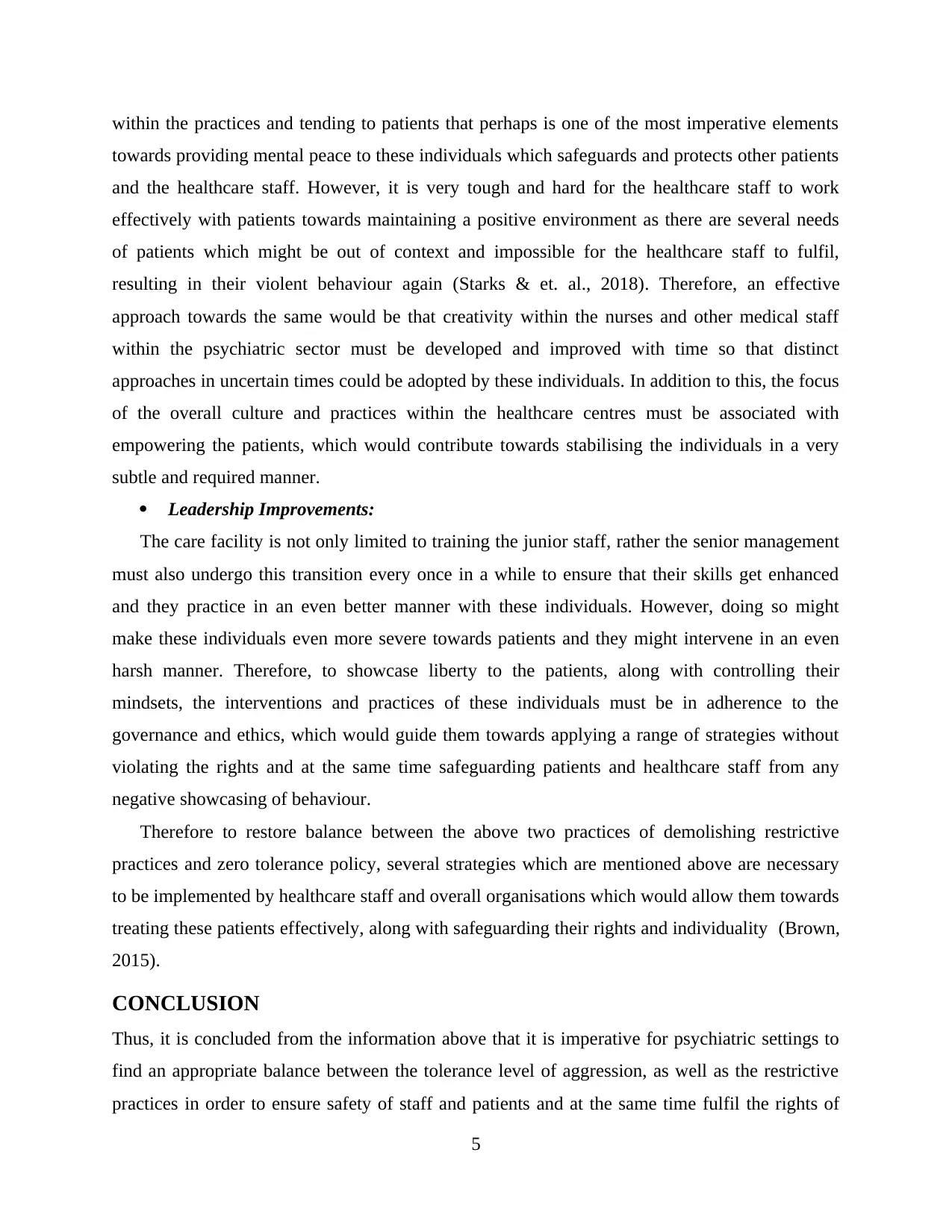
within the practices and tending to patients that perhaps is one of the most imperative elements
towards providing mental peace to these individuals which safeguards and protects other patients
and the healthcare staff. However, it is very tough and hard for the healthcare staff to work
effectively with patients towards maintaining a positive environment as there are several needs
of patients which might be out of context and impossible for the healthcare staff to fulfil,
resulting in their violent behaviour again (Starks & et. al., 2018). Therefore, an effective
approach towards the same would be that creativity within the nurses and other medical staff
within the psychiatric sector must be developed and improved with time so that distinct
approaches in uncertain times could be adopted by these individuals. In addition to this, the focus
of the overall culture and practices within the healthcare centres must be associated with
empowering the patients, which would contribute towards stabilising the individuals in a very
subtle and required manner.
Leadership Improvements:
The care facility is not only limited to training the junior staff, rather the senior management
must also undergo this transition every once in a while to ensure that their skills get enhanced
and they practice in an even better manner with these individuals. However, doing so might
make these individuals even more severe towards patients and they might intervene in an even
harsh manner. Therefore, to showcase liberty to the patients, along with controlling their
mindsets, the interventions and practices of these individuals must be in adherence to the
governance and ethics, which would guide them towards applying a range of strategies without
violating the rights and at the same time safeguarding patients and healthcare staff from any
negative showcasing of behaviour.
Therefore to restore balance between the above two practices of demolishing restrictive
practices and zero tolerance policy, several strategies which are mentioned above are necessary
to be implemented by healthcare staff and overall organisations which would allow them towards
treating these patients effectively, along with safeguarding their rights and individuality (Brown,
2015).
CONCLUSION
Thus, it is concluded from the information above that it is imperative for psychiatric settings to
find an appropriate balance between the tolerance level of aggression, as well as the restrictive
practices in order to ensure safety of staff and patients and at the same time fulfil the rights of
5
towards providing mental peace to these individuals which safeguards and protects other patients
and the healthcare staff. However, it is very tough and hard for the healthcare staff to work
effectively with patients towards maintaining a positive environment as there are several needs
of patients which might be out of context and impossible for the healthcare staff to fulfil,
resulting in their violent behaviour again (Starks & et. al., 2018). Therefore, an effective
approach towards the same would be that creativity within the nurses and other medical staff
within the psychiatric sector must be developed and improved with time so that distinct
approaches in uncertain times could be adopted by these individuals. In addition to this, the focus
of the overall culture and practices within the healthcare centres must be associated with
empowering the patients, which would contribute towards stabilising the individuals in a very
subtle and required manner.
Leadership Improvements:
The care facility is not only limited to training the junior staff, rather the senior management
must also undergo this transition every once in a while to ensure that their skills get enhanced
and they practice in an even better manner with these individuals. However, doing so might
make these individuals even more severe towards patients and they might intervene in an even
harsh manner. Therefore, to showcase liberty to the patients, along with controlling their
mindsets, the interventions and practices of these individuals must be in adherence to the
governance and ethics, which would guide them towards applying a range of strategies without
violating the rights and at the same time safeguarding patients and healthcare staff from any
negative showcasing of behaviour.
Therefore to restore balance between the above two practices of demolishing restrictive
practices and zero tolerance policy, several strategies which are mentioned above are necessary
to be implemented by healthcare staff and overall organisations which would allow them towards
treating these patients effectively, along with safeguarding their rights and individuality (Brown,
2015).
CONCLUSION
Thus, it is concluded from the information above that it is imperative for psychiatric settings to
find an appropriate balance between the tolerance level of aggression, as well as the restrictive
practices in order to ensure safety of staff and patients and at the same time fulfil the rights of
5
Paraphrase This Document
Need a fresh take? Get an instant paraphrase of this document with our AI Paraphraser
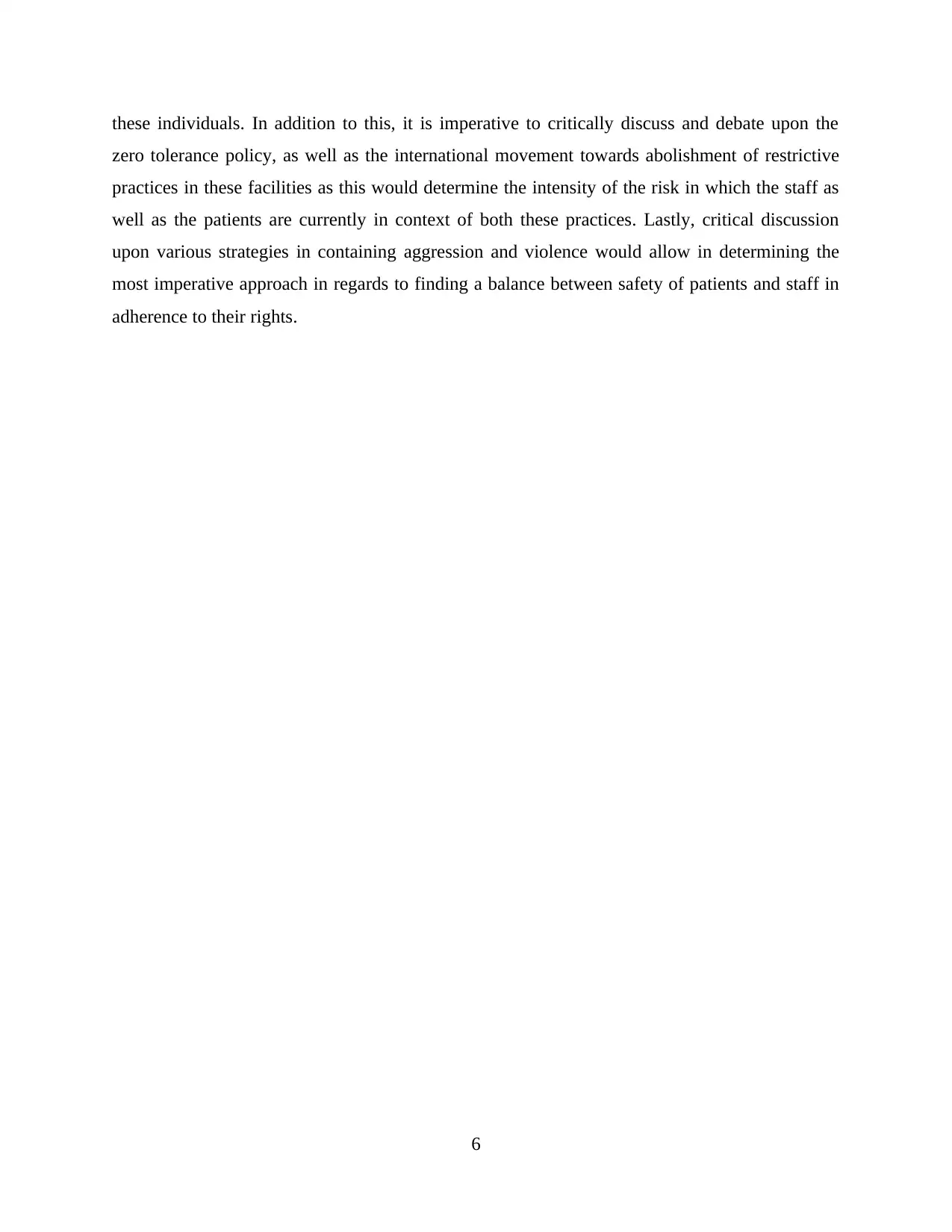
these individuals. In addition to this, it is imperative to critically discuss and debate upon the
zero tolerance policy, as well as the international movement towards abolishment of restrictive
practices in these facilities as this would determine the intensity of the risk in which the staff as
well as the patients are currently in context of both these practices. Lastly, critical discussion
upon various strategies in containing aggression and violence would allow in determining the
most imperative approach in regards to finding a balance between safety of patients and staff in
adherence to their rights.
6
zero tolerance policy, as well as the international movement towards abolishment of restrictive
practices in these facilities as this would determine the intensity of the risk in which the staff as
well as the patients are currently in context of both these practices. Lastly, critical discussion
upon various strategies in containing aggression and violence would allow in determining the
most imperative approach in regards to finding a balance between safety of patients and staff in
adherence to their rights.
6
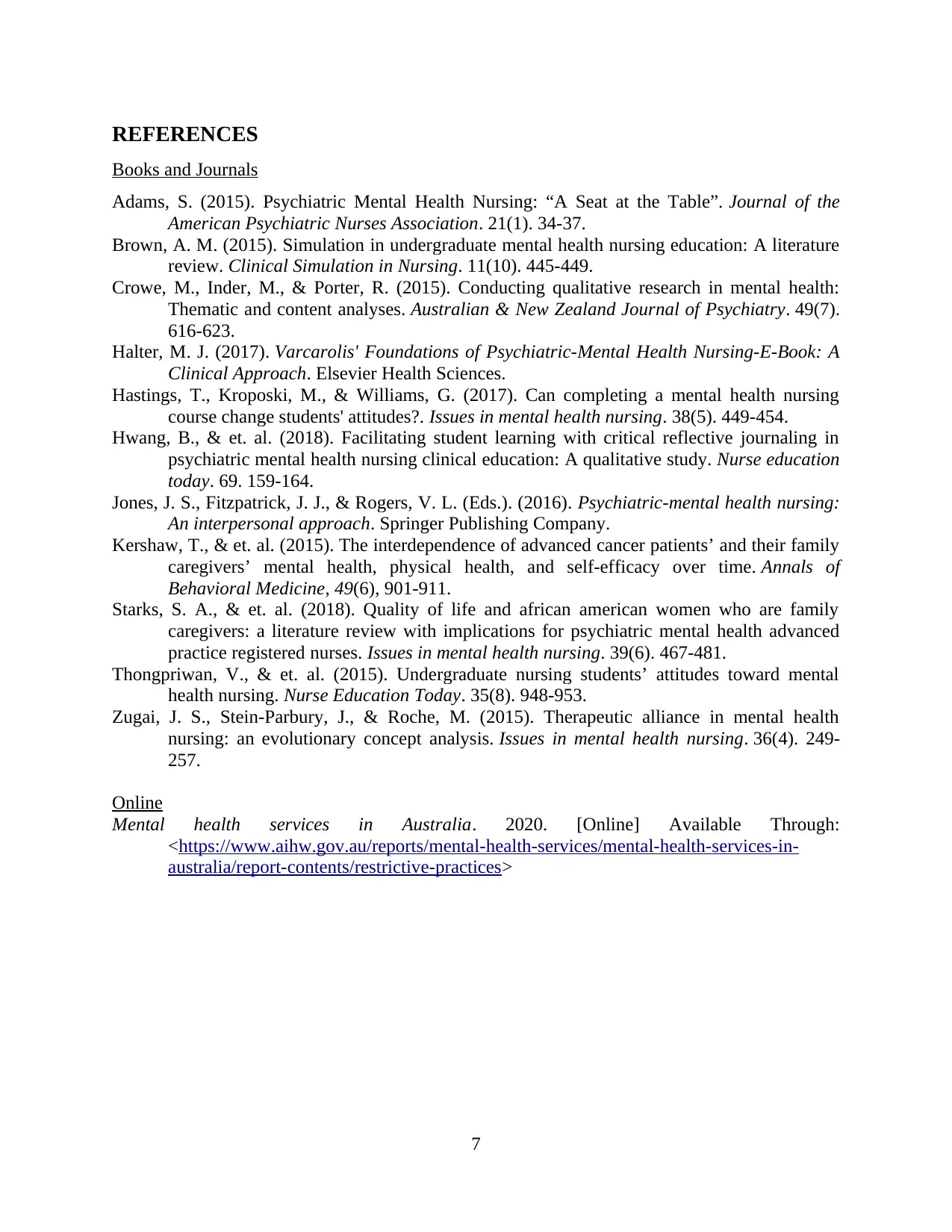
REFERENCES
Books and Journals
Adams, S. (2015). Psychiatric Mental Health Nursing: “A Seat at the Table”. Journal of the
American Psychiatric Nurses Association. 21(1). 34-37.
Brown, A. M. (2015). Simulation in undergraduate mental health nursing education: A literature
review. Clinical Simulation in Nursing. 11(10). 445-449.
Crowe, M., Inder, M., & Porter, R. (2015). Conducting qualitative research in mental health:
Thematic and content analyses. Australian & New Zealand Journal of Psychiatry. 49(7).
616-623.
Halter, M. J. (2017). Varcarolis' Foundations of Psychiatric-Mental Health Nursing-E-Book: A
Clinical Approach. Elsevier Health Sciences.
Hastings, T., Kroposki, M., & Williams, G. (2017). Can completing a mental health nursing
course change students' attitudes?. Issues in mental health nursing. 38(5). 449-454.
Hwang, B., & et. al. (2018). Facilitating student learning with critical reflective journaling in
psychiatric mental health nursing clinical education: A qualitative study. Nurse education
today. 69. 159-164.
Jones, J. S., Fitzpatrick, J. J., & Rogers, V. L. (Eds.). (2016). Psychiatric-mental health nursing:
An interpersonal approach. Springer Publishing Company.
Kershaw, T., & et. al. (2015). The interdependence of advanced cancer patients’ and their family
caregivers’ mental health, physical health, and self-efficacy over time. Annals of
Behavioral Medicine, 49(6), 901-911.
Starks, S. A., & et. al. (2018). Quality of life and african american women who are family
caregivers: a literature review with implications for psychiatric mental health advanced
practice registered nurses. Issues in mental health nursing. 39(6). 467-481.
Thongpriwan, V., & et. al. (2015). Undergraduate nursing students’ attitudes toward mental
health nursing. Nurse Education Today. 35(8). 948-953.
Zugai, J. S., Stein-Parbury, J., & Roche, M. (2015). Therapeutic alliance in mental health
nursing: an evolutionary concept analysis. Issues in mental health nursing. 36(4). 249-
257.
Online
Mental health services in Australia. 2020. [Online] Available Through:
<https://www.aihw.gov.au/reports/mental-health-services/mental-health-services-in-
australia/report-contents/restrictive-practices>
7
Books and Journals
Adams, S. (2015). Psychiatric Mental Health Nursing: “A Seat at the Table”. Journal of the
American Psychiatric Nurses Association. 21(1). 34-37.
Brown, A. M. (2015). Simulation in undergraduate mental health nursing education: A literature
review. Clinical Simulation in Nursing. 11(10). 445-449.
Crowe, M., Inder, M., & Porter, R. (2015). Conducting qualitative research in mental health:
Thematic and content analyses. Australian & New Zealand Journal of Psychiatry. 49(7).
616-623.
Halter, M. J. (2017). Varcarolis' Foundations of Psychiatric-Mental Health Nursing-E-Book: A
Clinical Approach. Elsevier Health Sciences.
Hastings, T., Kroposki, M., & Williams, G. (2017). Can completing a mental health nursing
course change students' attitudes?. Issues in mental health nursing. 38(5). 449-454.
Hwang, B., & et. al. (2018). Facilitating student learning with critical reflective journaling in
psychiatric mental health nursing clinical education: A qualitative study. Nurse education
today. 69. 159-164.
Jones, J. S., Fitzpatrick, J. J., & Rogers, V. L. (Eds.). (2016). Psychiatric-mental health nursing:
An interpersonal approach. Springer Publishing Company.
Kershaw, T., & et. al. (2015). The interdependence of advanced cancer patients’ and their family
caregivers’ mental health, physical health, and self-efficacy over time. Annals of
Behavioral Medicine, 49(6), 901-911.
Starks, S. A., & et. al. (2018). Quality of life and african american women who are family
caregivers: a literature review with implications for psychiatric mental health advanced
practice registered nurses. Issues in mental health nursing. 39(6). 467-481.
Thongpriwan, V., & et. al. (2015). Undergraduate nursing students’ attitudes toward mental
health nursing. Nurse Education Today. 35(8). 948-953.
Zugai, J. S., Stein-Parbury, J., & Roche, M. (2015). Therapeutic alliance in mental health
nursing: an evolutionary concept analysis. Issues in mental health nursing. 36(4). 249-
257.
Online
Mental health services in Australia. 2020. [Online] Available Through:
<https://www.aihw.gov.au/reports/mental-health-services/mental-health-services-in-
australia/report-contents/restrictive-practices>
7
⊘ This is a preview!⊘
Do you want full access?
Subscribe today to unlock all pages.

Trusted by 1+ million students worldwide
1 out of 9
Related Documents
Your All-in-One AI-Powered Toolkit for Academic Success.
+13062052269
info@desklib.com
Available 24*7 on WhatsApp / Email
![[object Object]](/_next/static/media/star-bottom.7253800d.svg)
Unlock your academic potential
Copyright © 2020–2025 A2Z Services. All Rights Reserved. Developed and managed by ZUCOL.





